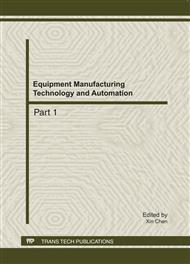[1]
C. Tomasi and T. Kanade: International Journal of Computer Vision, vol. 9, no. 2, pp.137-154. (1992)
Google Scholar
[2]
Y. Wan and Z. Miao, in: Proceedings of 2009 International Conference on Digital Image Processing, pp.163-166. (2009)
Google Scholar
[3]
W.-Z. Zhang, Z.-K. Pan, Y. Wang, in: Proceedings of the 7th International Conference on Machine Learning and Cybernetics, vol. 5, pp.3011-3016. (2008)
Google Scholar
[4]
G. Wang and Q. M. Jonathan: IEEE Transactions on Circuits and Systems for Video Technology, vol. 19, pp.1793-1803. (2009)
Google Scholar
[5]
Z. Chen, C.-H. Wu, W.-C. Chen, in: 2008 3DTV-Conference: The True Vision - Capture, Transmission and Display of 3D Video, pp.305-308. (2008)
DOI: 10.1109/3dtv-con13624.2008
Google Scholar
[6]
T. Kanade and D. Morris: Philosophical Transactions of the Royal Society of London, vol. A, no. 356, p.1,153-1,173. (1998)
Google Scholar
[7]
J. Oliensis and R. Hartley: IEEE Trans. Pattern Anal. Mach. Intell., vol. 29, no.12, p.2217–2233. (2007)
DOI: 10.1109/tpami.2007.1132
Google Scholar
[8]
P. Marc, V.G. Luc, V. Maarten, V. Frank, C. Kurt, T. Jan, K. Reinhard: International Journal of Computer Vision, vol. 59, pp.207-232. (2004)
Google Scholar
[9]
Y.-K. Zhang and X. Yang, in: International Conference on Signal Processing Proceedings, pp.1368-1371. (2008)
Google Scholar
[10]
P. Sturm, B. Triggs, in: 4th European Conference on Computer Vision, Cambridge, England. (1996)
Google Scholar
[11]
M. Shyjan and H. Martial, in: Proceedings of the IEEE Computer Society Conference on Computer Vision and Pattern Recognition, vol. 2, pp.430-437. (2000)
Google Scholar
[12]
M. Irani and P. Anandan, in: European Conf, Computer Vision'2000, p.539–553. (2000)
Google Scholar
[13]
D.W. Jacobs: Computer Vision and Image Understanding, 82(1), p.57–81. (2001)
Google Scholar
[14]
D. Morris and T. Kanade, in: Int. Conf. Computer Vision, p.696–702. (1998)
Google Scholar
[15]
S. Y. Chen and Y. F. Li: IEEE Transactions on Systems, Man and Cybernetics, Part B, Vol. 34, No. 1, pp.393-408. (2004)
Google Scholar
[16]
D. Lowe: International Journal of Computer Vision, 60(2), pp.91-110. (2004)
Google Scholar
[17]
M.A. Fischer, R.C. Bolles: Communication of ACM, J. vol. 24, p.381−395. (1981)
Google Scholar
[18]
C. Li, J. Zheng, C. Dang and H. Zhou, in: 2nd International Congress on Image and Signal Processing. (2009)
Google Scholar
[19]
R. Hartley and A. Zisserman: Cambridge University Press. (2000)
Google Scholar
[20]
S. Ma, Z. Zhang: Beijing, Science Press. (1998)
Google Scholar
[21]
S. Y. Chen, Y. F. Li, J.W. Zhang, "Vision Processing for Realtime 3D Data Acquisition Based on Coded Structured Light", IEEE Transactions on Image Processing, Vol. 17, No. 2, pp.167-176 , Feb. 2008.
DOI: 10.1109/tip.2007.914755
Google Scholar
[22]
A. Zisserman: Vison Geometry Group Data, http://www.robots.ox.ac.uk/~vgg/data/.
Google Scholar


